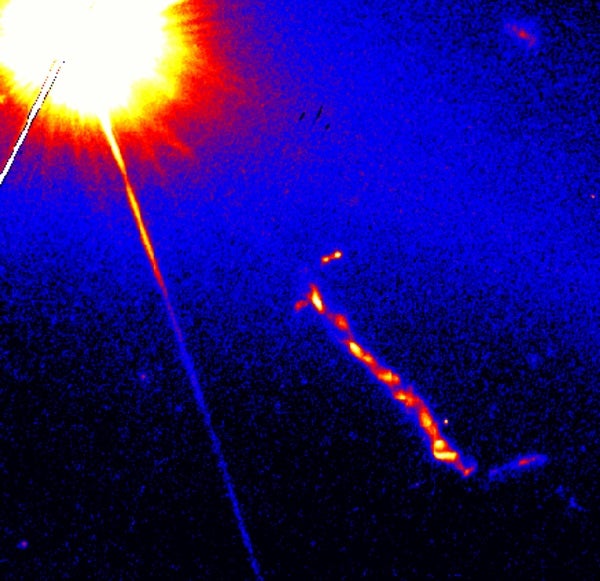Astronomers know that a giant black hole sits in the center of each large galaxy. This black hole can weigh anywhere between a few million times our Sun’s mass to tens of billions of times our Sun’s mass.
A black hole’s extreme mass means it has a huge gravitational force that pulls in all material nearby — like, from a passing gas cloud or star — to form a disk of gas and dust around the black hole. Friction in this accretion disk causes it to glow, and that light energizes more nearby material. Thus, the area surrounding the supermassive black hole glows in visible, ultraviolet, and X-ray light. When a galaxy’s central black hole is pulling in material and glowing, astronomers call it an active galactic nucleus, or AGN. The brightest and most energetic type of AGN is a quasar.
Depending on the orientation of the active black hole to Earth, scientists will see a different type of AGN. This illustration shows three examples. If we’re looking down the jet, we see a blazar. If we’re looking at its side, and thus through its thick dusty doughnut-shaped torus, we see an edge-on radio galaxy. And if we look at a shallow angle to perpendicular, and so seeing a very bright accretion disk and surrounding material, the object is cataloged as a quasar.
In the 1960s, the first quasar was identified. Astronomers cataloged these objects before that time, but they weren’t sure what they were. Then in 1963, Maarten Schmidt of the California Institute of Technology realized that the object 3C 273 is an extremely energetic source of radiation some 2 billion light-years from Earth. Now astronomers know that 3C 273 is the nearest quasar to us. The most distant quasar scientists have found is that tiny red dot in the center, called ULAS J1120+0641. It existed just 800 million years after the Big Bang, so when astronomers observe this object, they’re looking at a very early time in cosmic history.
Other types of active galaxies lie closer to Earth. Centaurus A is a radio-loud AGN about 11 million light-years from us. NGC 1275, also known as Perseus A, is a Seyfert type of AGN that lies about 230 million light-years from our planet. This black hole is likely oriented at shallow angle to edge-on. M84 is another radio-loud AGN that lies about 60 million light-years from Earth.
There’s a wild world of active galaxies out in the universe, and astronomers use them to study the extremes of energy and gravity.
Expand your knowledge at Astronomy.com
Check out the complete Astronomy 101 series
Learn about our stellar neighborhood with the Tour the Solar System series
Read about the latest astronomy news












